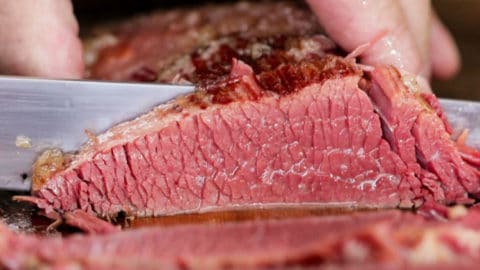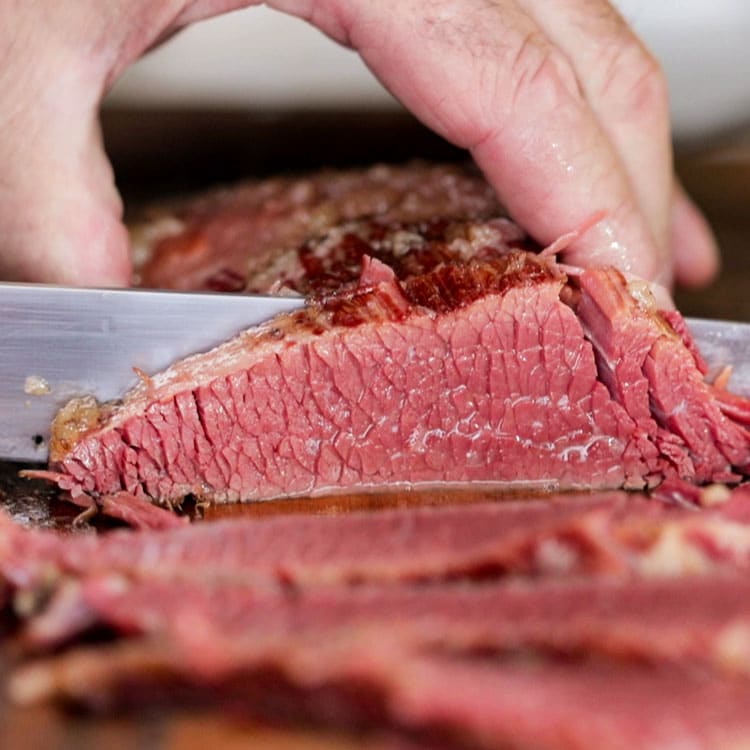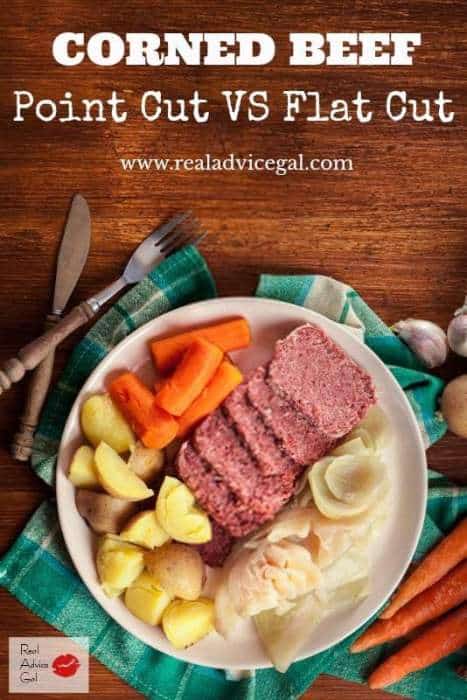Introduction

Corned beef and beef brisket are two popular cuts of meat that are often compared due to their similarities in appearance and preparation methods. However, there are distinct differences in flavor, texture, and cooking techniques between the two. Corned beef is typically associated with St. Patrick’s Day and Irish cuisine, while beef brisket is a versatile cut that can be prepared in various ways. In this article, we will delve deeper into the characteristics of corned beef and beef brisket, providing you with a better understanding of each and helping you decide which one is more suitable for your next meal.
Background On Corned Beef Vs Beef Brisket Comparison
Corned beef and beef brisket are two cuts of meat that are frequently compared due to their similarities in appearance. Corned beef is commonly associated with St. Patrick’s Day and Irish cuisine, while beef brisket is a versatile cut that can be prepared in various ways. While both cuts come from the chest area of the cow, there are distinct differences in flavor, texture, and cooking methods. Understanding these differences can help individuals choose the right meat for their desired dish.
What Is Corned Beef?
Corned beef is a type of meat that is made from brisket, which is a cut of beef from the breast or lower chest of a cow. The term “corned” refers to the curing process that involves preserving the meat in a brine solution made of water and salt. This curing process helps to give corned beef its signature salty flavor. Corned beef is often associated with St. Patrick’s Day and is commonly used in dishes such as sandwiches, stews, and corned beef hash. Its distinct flavor and tender texture make it a popular choice for many recipes and occasions.
Corned Beef Origin And Preparation

Corned beef has a rich history that dates back centuries. It originated in Europe, particularly in Ireland, where it was traditionally made by dry-curing beef with large grains of salt, also known as “corns.” This curing process helped to preserve the meat, making it last longer. Today, corned beef is typically prepared by soaking the beef brisket in a brine solution made of water, salt, sugar, and various spices. The meat is then simmered slowly until it becomes tender. The brine solution gives corned beef its distinct salty and savory flavor.
Corned Beef Flavor And Texture
Corned beef is known for its distinct salty and tangy flavor, thanks to the brining process it undergoes. The brine solution, consisting of water, salt, sugar, and various spices, infuses the beef brisket with its unique taste. When cooked, corned beef has a tender and succulent texture, although it can be slightly chewy. The slow simmering process helps break down the meat fibers, resulting in a melt-in-your-mouth texture. Corned beef can be sliced thinly for sandwiches or served in larger chunks for dishes like corned beef and cabbage. Its flavor and texture make it a popular choice for hearty meals.
What Is Beef Brisket?
Beef brisket is a cut of meat that comes from the breast or lower chest region of the cow. It is a tough and flavorful cut that requires slow cooking methods to tenderize and bring out its rich flavor. Brisket is often prepared by smoking, braising, or slow-roasting to achieve a tender and juicy texture. It is known for its intense beefy flavor and a balanced marbling of fat, which adds moisture and enhances the taste. Brisket is a versatile cut, used in various cuisines and dishes, such as barbecue, sandwiches, and traditional Jewish dishes like pastrami.
Beef Brisket Cut And Cooking Methods

Beef brisket is a cut of meat that comes from the breast or lower chest region of the cow. It is a tough and flavorful cut that requires slow cooking methods to tenderize and bring out its rich flavor. Brisket is often prepared by smoking, braising, or slow-roasting to achieve a tender and juicy texture. It is known for its intense beefy flavor and a balanced marbling of fat, which adds moisture and enhances the taste. Brisket is a versatile cut, used in various cuisines and dishes such as barbecue, sandwiches, and traditional Jewish dishes.
Beef Brisket Flavor And Tenderness
Beef brisket is renowned for its intense, rich beefy flavor. The slow cooking methods used to prepare brisket allow the meat to absorb seasoning and develop a deep, smoky taste. The marbling of fat in the brisket adds moisture and enhances the flavor, resulting in a juicy and tender texture. When properly cooked, brisket becomes melt-in-your-mouth tender, making it a favorite cut for barbecue enthusiasts. Whether smoked, braised, or slow-roasted, the flavor and tenderness of beef brisket make it a popular choice for a variety of dishes, from sandwiches to stews.
Nutritional Comparison
When comparing the nutritional profiles of corned beef and beef brisket, there are some key differences to consider. Corned beef is typically higher in sodium due to the brine-curing process, which can lead to concerns for those on a low-sodium diet. On the other hand, beef brisket is leaner and contains less sodium. Both cuts of meat are good sources of protein, iron, and B vitamins. It’s important to note that the nutritional content can vary depending on the specific cooking method and any added ingredients. Therefore, it is recommended to consider your dietary needs and preferences when choosing between corned beef and beef brisket.
Nutritional Value Of Corned Beef

Corned beef is a flavorful meat that packs a punch when it comes to nutrition. It is a good source of protein, providing around 23g per 100g serving. It is also rich in essential minerals such as iron, providing about 23% of the recommended daily intake. However, one thing to keep in mind is that corned beef is typically high in sodium due to the brine-curing process. This can be a concern for individuals on a low-sodium diet. It is always important to consider your dietary needs and consume corned beef in moderation.
Nutritional Value Of Beef Brisket
Beef brisket is a flavorful and tender cut of meat that also offers nutritional benefits. It is a good source of protein, providing around 27g per 100g serving. Additionally, beef brisket contains essential minerals such as iron, zinc, and selenium. However, it is important to note that beef brisket is higher in fat content compared to corned beef. It is recommended to choose lean cuts of beef brisket to reduce the intake of saturated fat. As with any meat, portion control and moderation are key for a balanced diet.
Cooking And Serving
Cooking and serving corned beef and beef brisket require different techniques to achieve desired flavors and textures. Corned beef is typically boiled or slow-cooked, resulting in tender and juicy meat. It is commonly served in sandwiches, with cabbage and potatoes, or sliced as a cold cut. On the other hand, beef brisket is often smoked or braised for several hours to achieve its tender and succulent texture. It is commonly served as a main course, either sliced or shredded. Both meats can be enjoyed in various dishes, depending on personal preference and culinary traditions.
Cooking Techniques For Corned Beef

Corned beef is typically cooked by boiling or slow-cooking to achieve tenderness and delicious flavor. To cook corned beef, start by rinsing the meat to remove excess brine. Place the corned beef in a large pot and cover with water. Bring it to a boil and then reduce the heat to a simmer. Cook the corned beef for about 3-4 hours until it is tender. Another method is to use a slow cooker, simply place the corned beef and liquid in the slow cooker and cook on low for 8-10 hours. Once cooked, slice the corned beef against the grain for optimum tenderness. Serve with cabbage, potatoes, or enjoy in a sandwich.
Cooking Techniques For Beef Brisket
Beef brisket is known for its tender and flavorful meat, but it requires special cooking techniques to bring out its full potential. The most popular method for cooking beef brisket is low and slow. This involves seasoning the brisket with a dry rub or marinade, then cooking it slowly over indirect heat or in a smoker. The low temperature and long cooking time help to break down the tough fibers in the meat and create a melt-in-your-mouth texture. It is important to monitor the internal temperature of the brisket to ensure it reaches the desired level of tenderness. Slicing the brisket against the grain will further enhance its tenderness. Serving beef brisket with a tangy barbecue sauce or alongside classic sides like coleslaw and baked beans completes the dish.
Conclusion
In conclusion, while corned beef and beef brisket may appear similar, they have distinct differences in terms of flavor, texture, and cooking methods. Corned beef is tender and succulent, with a unique salty and tangy taste. On the other hand, beef brisket is tougher but can become tender and juicy when cooked properly. It is important to choose the appropriate meat for specific recipes, as they cannot be easily substituted for one another. Whether it’s a St. Patrick’s Day feast or a backyard barbecue, understanding the differences between corned beef and beef brisket will enhance your culinary experience.
Differences And Similarities Between Corned Beef And Beef Brisket

Corned beef and beef brisket may appear similar, but they have distinct differences in flavor, texture, and cooking methods. Corned beef is tender and succulent, with a unique salty and tangy taste due to the brining process. In contrast, beef brisket is tougher but can become tender when cooked properly, with a rich and beefy flavor. Both cuts can be used in various recipes, such as sandwiches or stews, but it is important to choose the appropriate meat based on the desired outcome. Overall, understanding these differences will enhance your culinary experience.
Recommended Uses And Recipes
Corned beef and beef brisket can be used in a variety of delicious dishes. Corned beef is commonly used in traditional dishes like corned beef and cabbage, Reuben sandwiches, and corned beef hash. It also adds a flavorful twist to salads and casseroles. On the other hand, beef brisket is often smoked or slow-cooked to make tender and juicy barbecue. It can be enjoyed as a standalone dish or used in tacos, sandwiches, and chili. Both cuts of meat offer versatile options for hearty and satisfying meals. Experiment with different recipes to discover your favorite way to enjoy these flavorful meats.
FAQ About “corned Beef Vs Beef Brisket: A Meaty Comparison”
Q: What is the main difference between corned beef and beef brisket?
A: The main difference lies in the preparation method. Corned beef is beef brisket that has been cured in a brine solution, while beef brisket refers to the cut of meat itself.
Q: Which cut of meat is typically used for corned beef and beef brisket?
A: Both corned beef and beef brisket are made from the beef brisket cut, but they undergo different preparation processes.
Q: How do the flavor and texture differ between corned beef and beef brisket?
A: Corned beef tends to have a salty and tangy flavor due to the brining process, while beef brisket has a more natural beef taste. In terms of texture, corned beef is typically more tender and moist compared to beef brisket, which can be more firm and chewy.
Q: Can corned beef be substituted for beef brisket in recipes and vice versa?
A: While they come from the same cut of meat, the different preparation methods result in distinct flavors and textures. Substituting one for the other may alter the dish’s taste and consistency.
Q: How are corned beef and beef brisket commonly cooked?
A: Corned beef is often boiled or simmered, while beef brisket is frequently smoked, braised, or cooked low and slow to achieve a tender texture.
Q: Which dish is more commonly associated with certain cuisines or holidays?
A: Corned beef is a staple in dishes like Reuben sandwiches and corned beef hash, often enjoyed on St. Patrick’s Day. Beef brisket is popular in barbecue dishes like Texas-style brisket and Jewish-style brisket served during Passover.

Lenoir’s Bistro & Bakery, a charming and chic cafe, has been delighting patrons with an array of delectable delights since its inception. From mouthwatering breakfast bites to succulent burgers and sandwiches and a tempting selection of pasta, sides, and desserts, Lenoir’s Bistro & Bakery is the go-to destination for food enthusiasts seeking a delightful dining experience. Founded by a passionate culinary team with a vision to create a welcoming and stylish eatery, Lenoir’s Bistro & Bakery has seamlessly blended the art of baking with the craft of preparing savory dishes. The result is a menu that caters to diverse tastes and preferences, offering something to satisfy every craving.